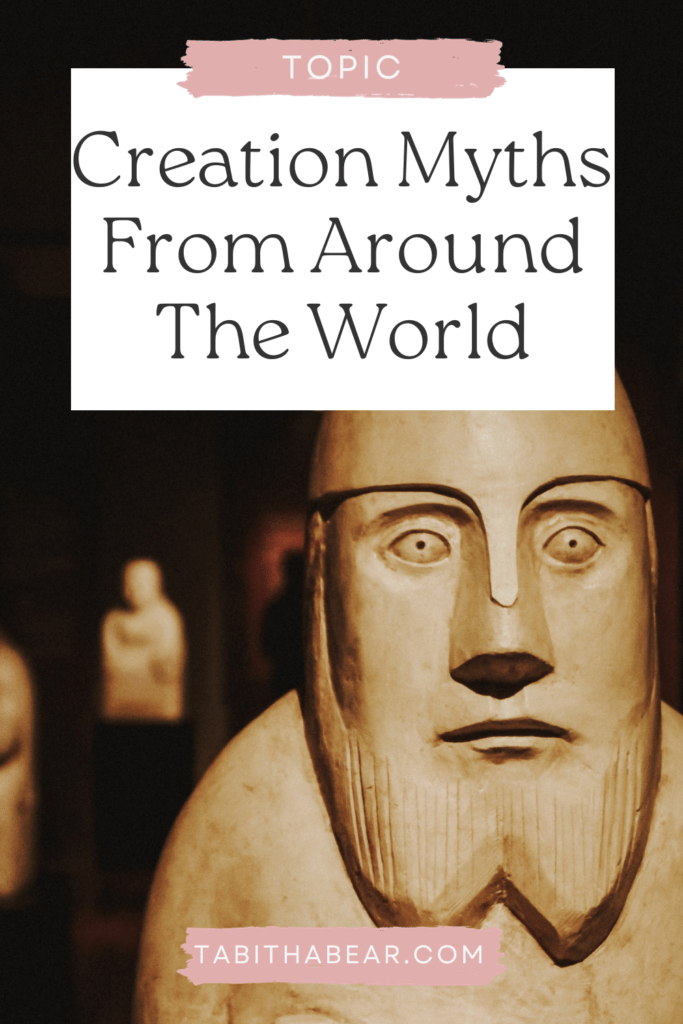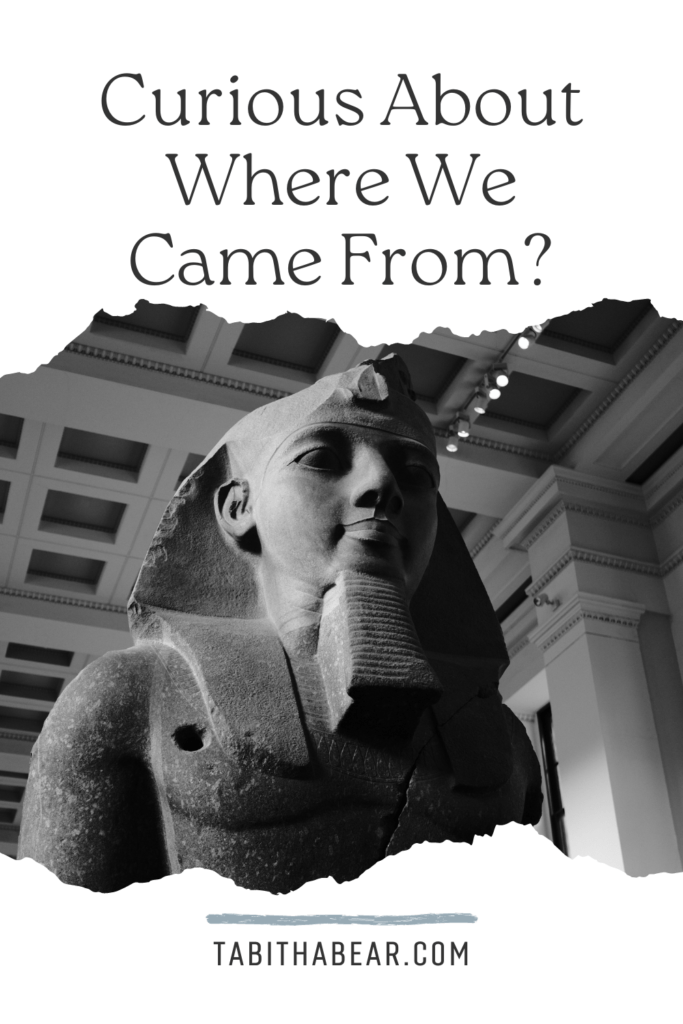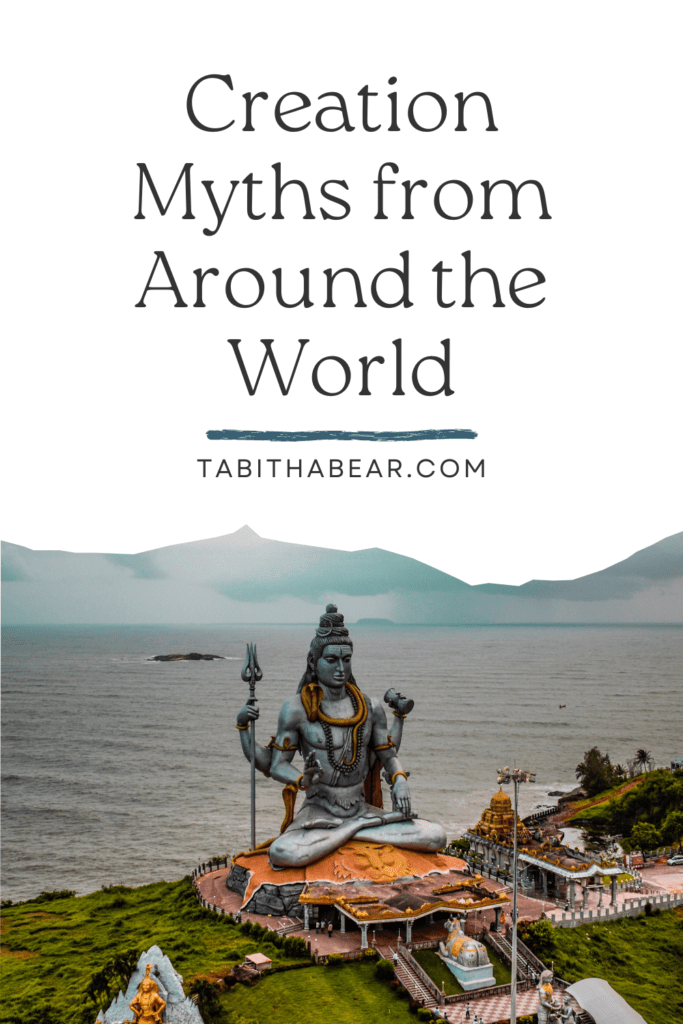
Even a really bad creator would at least have started with Earth, Air, Faire, Water and Surprise.
Terry Pratchett
In the vast tapestry of human beliefs and cultures, the myths of creation stand as some of the most profound and captivating narratives ever woven. From the depths of ancient times, these stories of origin offer us glimpses into the collective imagination of our species. They are the foundation upon which entire civilizations have been built, the keys to understanding the world as seen through the eyes of our ancestors.
In this exploration of creation myths, we embark on a journey across time and continents, exploring the rich and varied narratives that have sought to answer one of humanity’s most fundamental questions: How did it all begin?
Greek Mythology
The story begins with Chaos, a formless void, as the primordial state of existence. From Chaos emerges Gaia – the Earth – who becomes the foundation for the unfolding of the world. Gaia is often considered the first tangible entity and the mother of all life.
Gaia, in solitude, gives birth to Uranus – the sky. Uranus becomes both her partner and offspring, creating a harmonious union between Earth and Sky.
Gaia and Uranus produce a generation of powerful deities known as the Titans. These divine beings include Cronus (Kronos), Oceanus, Rhea, and a few others. They represent natural forces and elements, and their reign shapes the early cosmos.
Uranus feared the power of the Titans and hid some of them deep within Gaia. Gaia becomes restless and develops a desire for revenge. She creates a sickle from adamant – a legendary and indestructible metal. Gaia gives the sickle to Cronus who castrates Uranus.
His severed genitals fall into the sea and Aphrodite is born.
Uranus and the Titans’ rule comes to an end as they are eventually overthrown by Zeus, son of Cronus.
This is just an oversimplification of the foundation of Greek mythology. It reflects the ancient Greeks’ interpretation of the cosmos, starting with the Earth and Sky. Eventually it leads to generations of gods shaping different pieces of the world.
Norse Mythology
Norse mythology describes a cosmology with nine realms. This includes Midgard (the human world), Asgard (home of the Aesir), and Vanaheim (home of the Vanir). The world is connected by the great ash tree, Yggdrasil, which reaches through the realms.
The Aesir and Vanir are two groups of gods. The Aesir, including Odin, Thor, and Frigg, are associated with war, leadership, and wisdom. The Vanir, such as Freyja and Freyr, represent fertility, nature, and magic. Their interactions, including a war and an eventual peace treaty, shaped the divine world.
One of the central myths in Norse mythology involves the death of Baldr, the beloved god of light and purity. This was a result of Loki’s treachery. Baldr’s death triggered a series of events that ultimately leads to the cataclysmic events of Ragnarok.
Ragnarok is the prophesied end of the world in Norse mythology, marked by a series of catastrophic events, including battles, natural disasters, and the death of many gods. The world is then submerged in water and reborn.
Norse mythology has some influence from Christian beliefs and provides a unique glimpse into the worldviews and beliefs of the Germanic peoples of the Viking Age. It emphasizes the importance of honor, bravery, and destiny.
Hindu Mythology
Hindu mythology is often centered around the Trimurti. They are a trinity of gods that represent the cosmic processes of creation, preservation, and destruction. These gods are Brahma – the creator, Vishnu – the preserver, and Shiva – the destroyer.
The universe is cyclically created and destroyed. Lord Brahma is responsible for the creation of the cosmos, and his consort, Saraswati, embodies knowledge and the arts.
This mythology is intertwined with the beliefs of karma (the law of cause and effect) and reincarnation. These concepts dictate the cycle of birth, death, and rebirth until one achieves moksha – the liberation from the cycle of samsara.
Hinduism features a pantheon of countless deities, each with unique attributes and roles. Some of the most revered gods and goddesses include Vishnu – the preserver; Shiva – the destroyer; Lakshmi – goddess of wealth; Saraswati – goddess of knowledge; Durga – warrior goddess.
Hindu mythology is celebrated through a plethora of festivals and rituals, such as Diwali (Festival of Lights), Holi (Festival of Colors), and Navaratri (Nine Nights of Worship).
Hinduism is not just a collection of stories, but a dynamic and living tradition that continues to influence every aspect of life for millions of people. It offers profound insights into spirituality, ethics, and the pursuit of self-realization.
Chinese Mythology
Chinese mythology features quite the variety of creation myths, one being the story of Pangu. Pangu, a cosmic giant, emerges from the primordial chaos and begins to separate the elements of the universe. He becomes the Earth, with his breath forming the wind, his voice creating thunder, and his body forming the mountains and rivers.
This mythology also includes a pantheon of celestial beings, known as the Eight Immortals – Ba Xian. They are revered for their wisdom and supernatural abilities. They are often depicted as wise sages who offer guidance and aid to humans.
Chinese mythology is rich with various immortals, gods, and goddesses. Among the most revered are the Jade Emperor – ruler of Heaven; Guanyin – compassionate goddess of mercy; Erlang Shen – god of protection.
Dragons hold a significant place in Chinese mythology. They are considered benevolent and powerful creatures associated with water, rain, and good fortune. The Dragon is one of the twelve animals of the Chinese zodiac and symbolizes strength and longevity.
Chinese mythology is made up of symbolism, ethics, and cosmology. It reflects the profound interconnectedness of the natural and spiritual worlds, offering valuable insights into the beliefs and traditions that have shaped Chinese society for centuries.
Aboriginal Australian Mythology
Dreamtime is the core concept in Aboriginal mythology. It is not a linear concept of time, but rather a timeless state of existence. Dreamtime encompasses the past, present, and future. It is a spiritual and cosmological foundation for all of creation.
Creation stories in Aboriginal mythology vary among different Indigenous groups and regions, but they share common themes. They often involve ancestral beings or creator spirits. The creator spirits shaped the land, created living creatures, and established laws and customs. These beings are often associated with specific totemic animals, plants, or natural features.
Ancestral beings, often depicted as humans or animals, are central figures in creation stories. They are believed to have shaped the landscape and established the rules for human behavior and social structure.
Aboriginal mythology emphasizes a deep and sacred connection to the land. The Dreamtime stories are not just myths but are seen as living narratives that guide daily life, rituals, and relationships with the environment.
This mythology is a testament to the enduring strengths and resilience of Indigenous cultures. It underscores the importance of maintaining a profound connection to the land. It’s about respecting the wisdom of the ancestors, and preserving rich creation stories. They have shaped the world’s oldest continuous cultures.
Egyptian Mythology
Ma’at is a central concept in Egyptian mythology. It symbolized the cosmic and moral order that governed the universe. It was considered crucial for the stability and prosperity of both the natural and human worlds.
Egyptian mythology features multiple creation myths, one of the more prominent being the Heliopolitan creation story. In this narrative, Ra is the creator god who emerges from the primeval waters of Nun and produces the first divine couple, Shu and Tefnut.
Shu represents air and Tefnut water. Their union leads to the birth of Geb – the Earth – and Nut – the sky – creating a physical world. Nut gives birth to Osiris, Isis, Set, and Nepthys.
Ra – the sun god – was a significant deity in Egyptian mythology. He was believed to sail his solar boat across the sky during the day and to journey through the underworld at night. The daily cycle of the sun was seen as a symbol of rebirth and renewal.
Egyptian mythology, with its intricate pantheon and narratives, serves as a window into the worldview and values of ancient Egypt. It emphasizes the importance of order, balance, and the eternal cycle of life and death. It reflects the profound and cultural legacy of one of history’s most influential civilizations.
Mesopotamian Mythology
The Enuma Elish, which means ‘When on High’ in Akkadian, is the most famous Mesopotamian creation myth. It describes the birth of the cosmos and the struggle for supremacy among the gods.
The story begins with the primeval god Apsu – freshwater – and Tiamat – saltwater – which represented chaos. From their union, gods and goddesses emerge, creating the first generation of deities.
The god Marduk, associated with Babylon, becomes the central figure in the myth. He is chosen by the gods to defeat Tiamat. Tiamat had become a chaotic and destructive force. Marduk undergoes a transformation, becoming the most powerfully deity.
Marduk engaged in a cosmic battle with Tiamat, ultimately defeating her by splitting into her into two and using her body to create the Earth and heavens. This event established order and structure in the universe.
After Tiamat’s defeat, Marduk creates humanity from the blood of Kingu, a consort of Tiamat, symbolizing humanity’s subservience to the gods. Humans are created to serve the deities and relieve them from labor.
Mesopotamian myths of creation are quite epic and contain a complex divine hierarchy. It reflects the ancient Mesopotamians’ understanding of the cosmos and their relationship with the gods. It emphasizes the importance of divine order and the enduring connection between the divine and the mortal realms.
African Mythology
African Mythology is incredibly diverse, with distinct mythologies in different regions and among various ethnic groups. Each culture has its own set of deities, spirits, and creation stories.
Much of African mythology has been preserved through oral tradition, passed down from generation to generation through storytelling, songs, and rituals.
Ancestor veneration is a common theme in African mythology. Ancestors are believed to play a role in the lives of the living and are often consulted for guidance and protection.
African creation myths often revolve around the actions of a supreme being or a divine creator who brings order to the cosmos. These myths explain the origins of humanity, the natural world, and the relationships between humans, gods, and the land.
The Yoruba people of West Africa have a complex pantheon of gods known as the Orisha. In their creation myth, the world is formed by the god Obatala from a primordial substance and clay. Other gods, such as Olokun – goddess of the sea – and Oduduwa – progenitor of the Yoruba people – play important roles in shaping the world.
The Dogon people of Mali have a unique creation myth. In their mythology, the creator god Amma shapes the world and humanity. The Nommo, amphibious beings, help humans acquire knowledge and wisdom.
The San people, also known as Bushmen, have creation stories related to the mantis god Cagn. These myths often involve the adventures of the trickster figure, Mantis, in creating and shaping the world.
African mythology is a testament to the cultural and spiritual richness of the continent. It reflects the profound connections between people, gods, ancestors, and the land. These myths continue to be a source of inspiration and cultural identity for African communities, providing valuable insights into the diversity of human beliefs and worldviews.
More Folklore
In exploring the myths of creation from around the world, we embark on a journey through the collective imagination of humanity. These myths, whether from the grand halls of Egyptian temples, the oral traditions of African tribes, or the texts of ancient Mesopotamia, are not merely stories of the past; they are windows into our enduring quest to understand the origins of our existence.
They remind us that, despite our diversity, we share a common fascination with the mysteries of the cosmos and the forces that shape our world. From the vibrant diversity of African creation myths to the epic struggles of gods in Mesopotamia, these stories continue to resonate and inspire, reminding us of the timeless power of storytelling and our unending curiosity about the very beginnings of our existence.
You can find more Folklore HERE on the blog!

Never Miss An Adventure.



